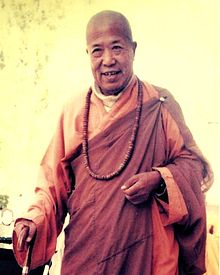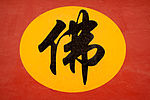|
Hsuan Hua
 Hsuan Hua (Chinese: 宣化; pinyin: Xuānhuà; lit. 'proclaim and transform'; April 26, 1918 – June 7, 1995), also known as An Tzu, Tu Lun and Master Hua by his Western disciples, was a Chinese monk of Chan Buddhism and a contributing figure in bringing Chinese Buddhism to the United States in the late 20th century. Hsuan Hua founded several institutions in the US. The Dharma Realm Buddhist Association (DRBA) is a Buddhist organization with chapters in North America, Australia and Asia. The City of Ten Thousand Buddhas (CTTB) in Ukiah, California, is one of the first Chan Buddhist monasteries in America. Hsuan Hua founded Dharma Realm Buddhist University at CTTB. The Buddhist Text Translation Society works on the phonetics and translation of Buddhist scriptures from Chinese into English, Vietnamese, Spanish, and many other languages.[1] Early lifeHsuan Hua, born on the sixteenth day of the third lunar month in the year of Wuwu (Horse), April 26, 1918. Named Bai Yushu or Bai Yuxi simplified Chinese: 白玉书 (白玉禧); traditional Chinese: 白玉書 (白玉璽); pinyin: Báiyù shū (Báiyù xǐ); lit. 'White Jade Book (White Jade Jubilee)' in Shuangcheng County of Jilin (now Wuchang, Harbin, Heilongjiang).[2][3] After his birth, he cried for three days out of pity for beings in the saha world. Following a similar story of Gautama Siddhartha's Four Sights (the sight of a oldman, sick man, a corpse and an ascetic) which lead him to his realization. At age eleven Hsuan Hua saw a dead infant in the wild and he too contemplated about the nature of the Impermanence and Saṃsāra (cycle of birth and dead ) of the baby. That's when he resolved to leave home and cultivate the way, but didn't at the request of his mother. His mother was a vegetarian and held to the practice of reciting the name of Amitabha Buddha throughout her life. As a child, followed his mother’s example.[3][4] At the age of twelve, he began bowing every day to repent his faults to his parents as an act of filial piety. Later he felt it was not enough to bow to them, so he gradually increased his bows to his teachers, the Emperor, the heavens, the earth until he was bowing to all living beings, hoping to bring peace to the world. He bowed every morning and evening, each time making more than 830 bows, which took five hours a day.[3] His cultivation is in reference to the Great Learning (simplified Chinese: 大学; traditional Chinese: 大學; pinyin: DàXué), one of the Four Books of Confucianism, where one and align his affairs and relationships into order and harmony by first cultivativating oneself, then extending it to others. He request, to his parents, to leave so that he could find a teacher to help him on his spiritual path. After some time, with his parents’ permission he set forth and traveled in search of a true spiritual teacher. At fifteen Hsuan Hu took refuge with the Three Jewels under Venerable High Master Changzhi of Sanyuan Monastery in Harbin. He drew near the Abbot, Venerable High Master Changren.[2][4] EducationAfter finding a spiritual teacher, Hsuan Hua enrolled into a private village school from the twelfth day of the third lunar month to the thirteenth day of the eighth lunar month in the year of Ren Shen (Monkey), April 16 to September 13, 1932, where he had his first experience of formal education.[2] Studied with single-minded concentration, he was able to memorize after reading it once using his photographic memory. At the age of sixteen he had already started to lecture on the Buddhist sutras to the fellow villagers who were mainly illiterate. Being well versed in the Sixth Patriarch's Dharma Jewel Platform Sutra, the Vajra Sutra, the Amitabha Sutra, and other Buddhist texts.[2][4] As a student and a practitioner, he was a part of many charity organizations such as the Buddhist Association, the Moral Society of Manchuria, the Charity Society, organizations that help encourage people to quit smoking and drinking, and others unskillful means. To help teach people to refrain from all evil and practicing all good.[3] After two more years of study he had already mastered the core texts of Confucianism, Four Books, the Five Classics, other various Chinese schools of thought, studied traditional Chinese medicine, astrology, divination, physiognomy, and the scriptures of the great religions.[3][4] At age eighteen Hsuan Hu with first-hand experience, understood the hardships that came with not having a complete education. He decided to established a free school teaching thirty impoverished children and adults, being the only teacher and faculty member. By that point he had already quit school in order to take care of his ill mother.[3][4] Monastic LifeAt 19 years of age, Hua became a monastic, under the Dharma name An Tzu.[citation needed] (安慈) Bringing Buddhadharma to the United StatesIn 1959, Hsuan Hua sought to bring Chinese Buddhism to the West.[5] He instructed his disciples in America to establish a Buddhist association, initially known as The Buddhist Lecture Hall, which was renamed the Sino-American Buddhist Association before taking its present name: the Dharma Realm Buddhist Association.[citation needed] Hsuan Hua traveled to Australia in 1961 and taught there for one year, returning to Hong Kong in 1962. That same year, at the invitation of American Buddhists, he traveled to the United States; his intent was to "come to America to create Patriarchs, to create Buddhas, to create Bodhisattvas".[6] San FranciscoHsuan Hua resided in San Francisco, where he built a lecture hall. Hsuan Hua began to attract young Americans who were interested in meditation. He conducted daily meditation sessions and frequent Sutra lectures.[citation needed] At that time, the Cuban Missile Crisis occurred between the United States and the Soviet Union, and Hsuan Hua embarked on a fasting period for thirty-five days to pray for an end to the hostilities and for world peace. In 1967, Hsuan Hua moved the Buddhist Lecture Hall back to Chinatown, locating it in the Tianhou Temple.[citation needed] First American SanghaIn 1968, Hsuan Hua held a Shurangama Study and Practice Summer Session. Over thirty students from the University of Washington in Seattle came to study the Buddha's teachings. After the session was concluded, five young Americans (Bhikṣu Heng Chyan, Heng Jing, and Heng Shou, and Bhikṣuṇīs Heng Yin and Heng Ch'ih) requested permission to take full ordination.[7] Hsuan Hua lectured on the entire Śūraṅgama Sūtra in 1968 while he was in the United States. These lectures were recorded in an eight-part series of books containing the sutra and a traditionally rigorous form of commentary that addresses each passage. It was again lectured by the original translator monks and nuns of the City of Ten Thousand Buddhas at Dharma Realm Buddhist University in the summer of 2003.[citation needed] Vision of American BuddhismWith the founding of his American Sangha, Hsuan Hua embarked on his personal vision for Buddhism in the United States:
Hosting ordination ceremoniesBecause of the increasing numbers of people who wished to become monks and nuns under Hsuan Hua's guidance, in 1972 he decided to hold ordination ceremonies at Gold Mountain Dhyana Monastery. Two monks and one nun received ordination. Subsequent ordination platforms have been held at the City of Ten Thousand Buddhas in 1976, 1979, 1982, 1989, 1991, and 1992, and progressively larger numbers of people have received full ordination. Over two hundred people from countries all over the world were ordained under him.[citation needed] Theravada and Mahayana traditionsHaving traveled to Thailand and Burma in his youth to investigate the Southern Tradition of Buddhism, Hsuan Hua wanted to bridge what he perceived as a rift between the Northern (Mahayana) and Southern (Theravada) traditions. In an address to Ajahn Sumedho and the monastic community at Amaravati Buddhist Monastery on October 6, 1990, Hsuan Hua stated:[10]
On the occasion of the opening ceremony for the Dharma Realm Buddhist University, Hsuan Hua presented K. Sri Dhammananda of the Theravada tradition with an honorary Ph.D. He also donated a major piece of the land that would become Abhayagiri Buddhist Monastery, a Theravada Buddhist monastery in the Thai Forest tradition of Ajahn Chah, located in Redwood Valley, California.[citation needed] Hsuan Hua would also invite Bhikkhus from both traditions to jointly conduct the High Ordination.[11] Chinese and American BuddhismFrom July 18 to the 24th of 1987, Hsuan Hua hosted the Water, Land, and Air Repentance Dharma Assembly, a centuries-old ritual often seen as the "king of dharma services" in Chinese Buddhism, at the City of Ten Thousand Buddhas and invited over seventy Buddhists from mainland China to attend. This was the first time the service was known to have been held in North America.[12] On November 6, 1990, Hsuan Hua sent his disciples to Beijing to bring the Dragon Treasury (Chinese: 龍藏; pinyin: lóngzáng) edition of the Chinese Buddhist canon back to CTTB, furthering his goal of bringing Buddhism to the US.[citation needed] DeathOn June 7, 1995, while visiting Long Beach Sagely Monastery, Hsuan Hua died in his sleep.[13] He had been ill for some time prior to his death at the age of 77.[13] His parting words were
FuneralHsuan Hua's funeral lasted from June 8 to July 29. On June 17, Hsuan Hua's body was placed in a refrigerated casket and taken from southern to northern California, returning to the City of Ten Thousand Buddhas to lie in repose. All major services during the funeral were presided over by Ming Yang, abbot of Longhua Temple in Shanghai and a longtime friend of Hsuan Hua's.[citation needed] On July 28, monks from both Theravada and Mahayana traditions hosted a memorial ceremony and cremation. More than two thousand followers from the United States, Canada, and various Asian and European countries, came to CTTB to take part in the funeral service. Letters of condolences from dignitaries including former President George H. W. Bush were read during the service.[citation needed] A day after the cremation, July 29, Hsuan Hua's ashes were scattered, at his request, in the open air above the City of Ten Thousand Buddhas from a hot air balloon by his first two disciples, Heng Sure and Heng Chau. After the funeral, memorial services commemorating Hsuan Hua's life were held in various parts of the world, including Taiwan, China, and Canada. His śarīra (relics) were then distributed to many of his temples, disciples, and followers.[citation needed] In MemoryWanting to keep Master Hua's Memories alive, a project by Dharma Realm Buddhist Association (DRBA) called Dharma Radio was started by his followers, their wish being that Hua's teachings be accessible fulfilling Master Hua’s wish that Buddhism adapts to the cultural context of the West.[14] As well as a YouTube series called Master Hua's Oral History Project (宣化上人口述歷史影集) where many of the early disciples discuss fond memories of the Master.[15] See alsoReferences
External links |
|||||||||||||||||||||||||||||||||||||||||

